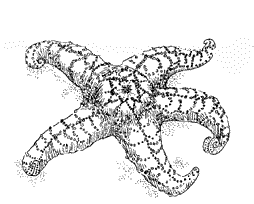| Recommendation: |
A broad coalition of local, state,
and national representatives from both the public and private sector are supporting the
establishment of a national marine science education camp program, beginning with a
flagship project in Central California: SeaCamp Monterey Bay. At the upcoming
National Ocean Conference, it is strongly recommended that the Clinton–Gore
Administration announce the establishment of SeaCamp Monterey Bay as a prototype
and the Administration’s enthusiastic support for the long-term development of a
national marine science camp program. This residential camp program, slated to
open in the Monterey region in 2000, is an exciting way that we can significantly improve
the quality and delivery of science-based education to our diverse American youth. By
launching its first campuses in the Monterey Bay area, the national program would take
advantage of the natural and institutional resources there, and successfully serve as a
model for similar marine camp programs in other parts of the United States, particularly
sites adjacent to national marine sanctuaries. |
| The Need: |
The United States will remain
competitive in the global economy only if we train our youth to apply basic science and
technology in the use and management of our finite natural resources. The national decline
in the quality of public education is well documented. Mounting fiscal constraints and the
lack of adequate attention to providing curricula which meet students needs are often
blamed. SeaCamp Monterey Bay, and the national marine science camp program in
general, would be an innovative approach to addressing specific shortcomings in our
current educational systems, including the general lack of opportunities for intensive
student participation in the sciences, technology, and outdoor physical activities.
Moreover, SeaCamp Monterey Bay, by using the marine and coastal environments as its
laboratory, is designed to instill in our youth a practical understanding and appreciation
of the scientific process and critical thinking. Equally important, it will motivate
students to use this knowledge to address our pressing coastal and marine resource issues
as they become the thoughtful stewards of our oceans and members of our work force in the
21st century. |
| Why Monterey Bay: |
The Monterey Bay region of
California is a leading center world-wide for marine research and education; all are
attracted by the national park-like qualities of the region’s coast and ocean
environments. Today, more than twenty government agencies and teaching institutions
devoted to coastal and marine studies are located on the rim of Monterey Bay, including
the Monterey Bay National Marine Sanctuary program. In addition, there are numerous
marine-related business and technological programs. Collaboration among these critical
partners is essential, as SeaCamp Monterey Bay is weaved around the existing
excellent programs in the area. |
| Why the Ocean Summit: |
The United Nations has declared
1998 as the International Year of the Ocean and is developing an Oceans Initiative.
President Clinton proclaimed 1998 as the Year of the Ocean, calling on all nations to
"work in partnership to become wise stewards …." The National Ocean
Conference provides the perfect opportunity for the Clinton–Gore Administration to
underscore its stated commitment to improving education and the management of our ocean
planet by announcing its support of the national marine science camp program. SeaCamp
Monterey Bay will produce students who not only understand the scientific process, but
also how their daily activities impact marine and coastal processes, how future actions
can help sustain a viable environment, and the value of life-long ocean stewardship. |
| The Initiative: |
The marine science education camp
will offer intense, field-oriented, residential programs for elementary and secondary
students, including those from economically challenged settings and diverse cultural
backgrounds. The programs will combine interactive classroom projects, field seminars, and
visits to educational exhibits and activity centers. Introducing students to careers in
the coastal zone via close interactions with professional mentors in business,
agriculture, science, public policy and conservation, will be a hallmark. Collaborators
include the National Ocean Service of NOAA, the California Coastal Commission, the
Monterey Bay Aquarium, Moss Landing Marine Laboratories, the Monterey Bay National Marine
Sanctuary, Santa Cruz Office of Education, Monterey County Office of Education, the
Elkhorn National Estuarine Research Reserve, California State University at Monterey Bay,
University of California at Santa Cruz and the University of California Sea Grant Program. |
| Resources Needed: |
An estimated $6.5 million are
needed to make SeaCamp Monterey Bay fully operational. In the meantime, $1.5
million is needed for the science program to open its doors with pilot programs in 2000.
An annual operating budget of around $5 million is expected to come from a combination of
fees, grants, gifts, and public-sector contributions. |


![]() Return to the California Coastal Commission home page.
Return to the California Coastal Commission home page.